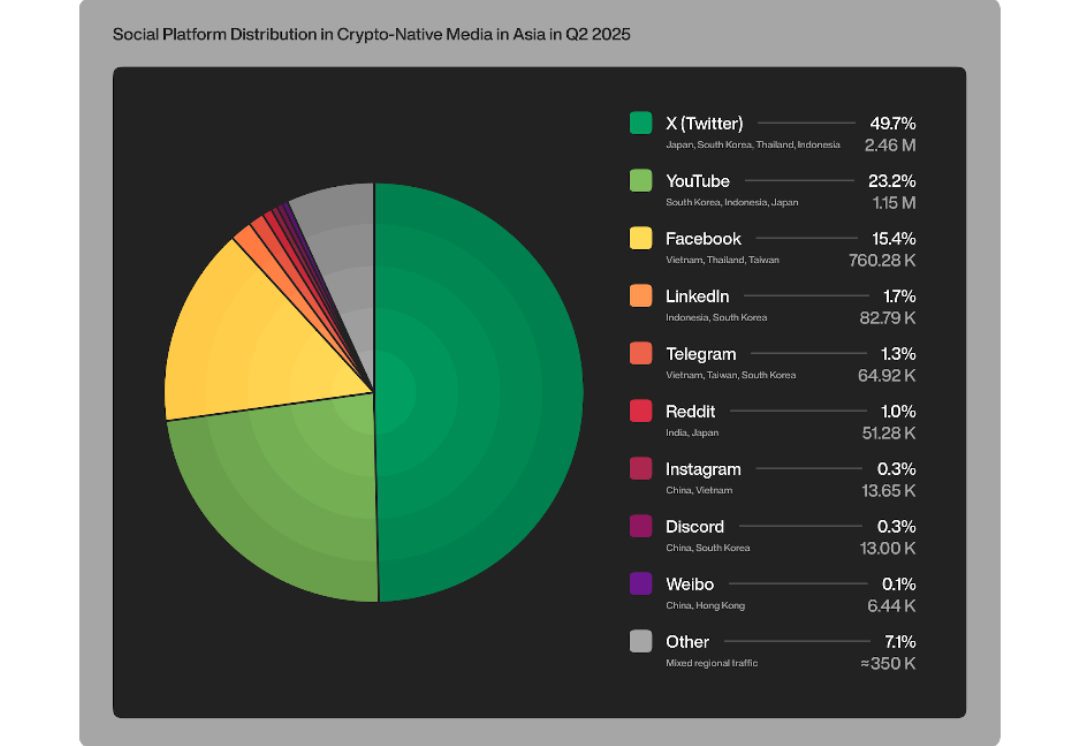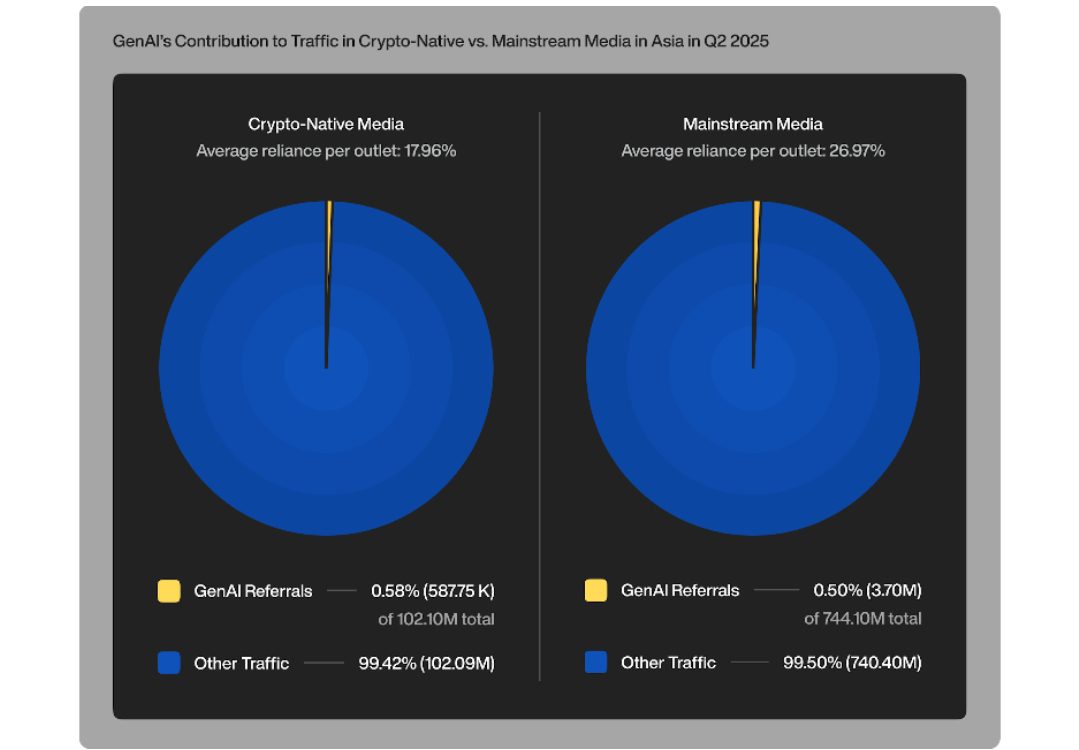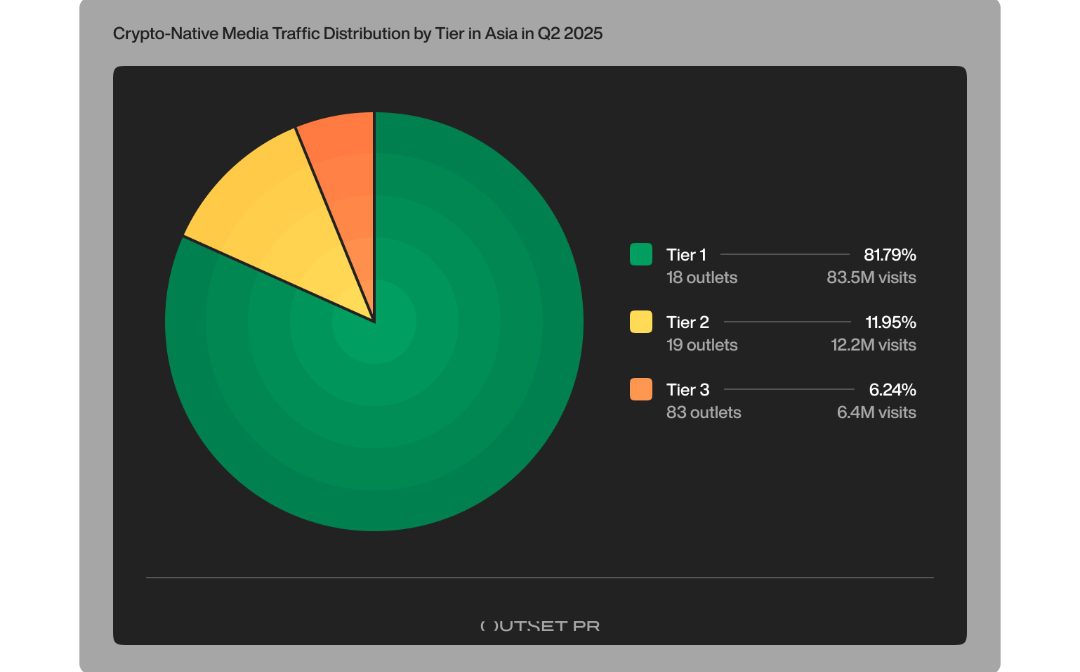Asia’s crypto market presents interesting trends that are unique to the region. According to Outset Data Pulse, Outset PR’s ongoing system for tracking crypto news performs across regions and the engine behind their latest Asia report, X drives almost half of all social engagement in this region at almost 50%, with YouTube following at 23%.
This split tells an interesting story: the conversation happens on social, but the real authority lives on homepages readers trust. It’s less “go viral” and more “be findable, then be worth returning to.”
Even though social platforms drive most of the conversation, they contribute only a small fraction of actual clicks — just over 5% — which shows how differently people talk about news versus where they ultimately read it.
As Maximilian Fondé, senior analyst at Outset PR, stated, “Social sets the tempo; direct keeps the audience. In Asia, that split is the signal.”
In reality, a headline could blow up on X at 9 AM, but the traffic peak lands on local outlets hours later after communities verify the claim and formulate context in their native languages.
How do Asians get their crypto news on social media?
Data shows Asian users get their crypto news in real time on X, through explainers on YouTube, and inside local-language groups that move faster than mainstream portals.
Think of it as a two-step process: feeds spark the update; trusted outlets supply the context. Traders check X for the quick summary and only then hop on to native websites for a deeper read.
In practice, social isn’t the final destination — it’s the notification layer. It tells readers what’s happening, and trusted outlets tell them why it matters.
Social platforms driving the most crypto engagement in Asia
Now that X and YouTube’s dominance is on the table, the rest of the ranking becomes clearer, with Facebook being the next major player, holding somewhat above 15%.
On the other side of the spectrum, LinkedIn accounts for just 1.67%, Telegram at 1.3%, Reddit at 1.04%, Instagram at 0.28%, and Discord at 0.26%.

Source: Outset Data Pulse
What this means in reality is X behaves like a market ticker and offers fast takes, policy headlines, price shocks. YouTube offers how-tos and debriefs while Facebook is the sort-of neighbourhood bulletin board in a few markets. LinkedIn and Telegram are smaller by volume but often decide who gets cited by pros.
This dynamic is also reflected in how Asia’s biggest outlets move across these platforms. Brands like Coinpan, CoinPost, BlockMedia, and TokenPost often see their stories gain early traction on X or Facebook before the deeper traffic arrives directly on their homepages — a pattern that shows how social buzz and direct loyalty work together rather than separately.
The real picture becomes clearer when you look at what each platform actually does for crypto readers — and why they’ve grown into such distinct roles across Asia.
YouTube is the main place to learn about crypto in Asia
YouTube boasts nearly a quarter of social engagement with videos spanning long-form explainers, recaps, and AMAs in local languages. Creators have come to realize that visual walkthroughs are preferred over dense text when concepts are complex.
Creators who publish consistently are building durable “study habits” among viewers in South Korea, Indonesia, and Japan.
For many users, YouTube has become the closest thing to a classroom — a place where they can pause, rewatch, and actually understand what’s changing in the market instead of just reacting to headlines. That slow, structured learning loop is what keeps YouTube at the heart of crypto education in Asia.
Facebook still matters in Vietnam and Thailand, and here’s why
Local groups keep Facebook relevant. Early adoption in Vietnam and Thailand produced dense, language-specific communities that still handle Q&A, rumor-checking, and policy translation. This is a big reason why Facebook, not traditionally known as a place to gather crypto news and analysis, holds such a big share of social traffic.
These groups are well organized and typically include long-time moderators, scam watch posts, and even offline meetups. This proven formula is what builds trust and keeps readers inside Facebook even as newer platforms gain in popularity.
In these markets, Facebook functions less like a social feed and more like a public town square — a space where people ask, challenge, validate, and teach each other. That sense of community ownership is something newer platforms haven’t been able to replicate.
LinkedIn and Telegram are shaping Asia’s professional and community crypto circles
LinkedIn’s under 2% share is small, but still meaningful. Founders, funds, and analysts in Indonesia and South Korea use it for policy threads, hiring, and deal flow. Telegram’s share doesn’t reflect its real influence because private sharing is undercounted. In Vietnam and Indonesia, for example, Telegram is home to many project AMAs, alerts, and translations.
Notably, LinkedIn is where pitches get softened into thought leadership and hiring signals while Telegram is where communities translate, annotate, and escalate. Despite their small size, LinkedIn offers a major element of trust and Telegram dictates what to do next.
One sets the tone for how professionals think; the other sets the tone for how users act.
When a trend appears on LinkedIn, it becomes a talking point — when it spreads on Telegram, it becomes a movement.
Social media in Asia drives nearly all discussion
By Q2, it became clear that social platforms punch far above their weight. The volume may be small, but social platforms still set the narrative agenda — most storylines start, evolve, or get challenged there long before they reach the front pages. Trends, debates, and rumors all start there — and by the time readers arrive on native outlets, the narrative has already been framed.
It’s more accurate to think of social as the rehearsal space for crypto news: a place where ideas get tested, challenged, debunked, and reshaped in real time. What happens on X or inside native-language communities often determines how — or whether — a story gains momentum later.
The editorial implication is clear: outlets need to write for conversion even if direct and search keep dominating the click path. Outset PR reached a similar conclusion in its MiCA-focused analysis of Western Europe, arguing that the regulation has arrived but much of the region’s crypto media is not ready for it.
The Link Between Social Signals, AI Traffic, and Search Performance in Asian Crypto News
AI referrals remain small but are showing signs of accelerating growth. Current data shows AI referrals represent 0.58% of total crypto-native traffic in Asia, averaging around 17.96% of referral traffic per outlet. Some tier-1 outlets see this number peak near 68%.
What’s driving this growth is the way models interpret authority. Structured pages rank well, but social activity helps validate which stories matter, giving LLMs clearer signals about relevance. When a topic trends on X or circulates through regional groups, it becomes easier for AI systems to recognize and surface it.
Fondé notes, “Write for people, mark up for machines. SEO rewards clarity; LLMs reward structure and citation. If your piece is well-formed and socially validated, you get included in the answer.”

Source: Outset Data Pulse
Most crypto readers in Asia still go direct
Direct accounted for almost 55% of crypto-native traffic in Q2, while organic search contributed around 35%. Readers type in, bookmark, or open apps for brands they trust — and then head to social for the real-time conversation. Social may shape the noise, but direct is where people actually read. That balance is what keeps Asian outlets steady even when algorithms swing. Outset PR saw the same thing in Eastern Europe: when search becomes unstable, direct traffic is the anchor that keeps crypto outlets afloat.
Many observers misunderstand what “direct” really means. It isn’t just a traffic source; it’s a relationship. Newsletters, mobile shortcuts, Telegram alerts, and predictable publishing rhythms all feed into that habit loop. When readers know exactly where they want to be, they go there first — and talk about it on social later.
Asia’s mid-tier outlets are surviving on focus and consistency
The tier-1 umbrella consists of 18 outlets that account for approximately 82% of traffic. However, mid-tier outlets and niche publishers manage to survive through ownership of a narrow beat and shipping on cadence. Examples include AI-token trackers in Indonesia, regulatory changes in Thailand, or DeFi startups in Korea.
What happens in one country is typically of interest in another. For example, a Thai site that reports breaking news regarding a key policy update in the morning could see its work cited by bigger and international brands within hours. That citation loop is how small teams are able to thrive by focusing on what they are best at. This pattern echoes findings from Outset PR’s LATAM report, which showed a similar divide where niche outlets stayed resilient even as broad crypto media struggled for visibility.
Specific audiences, repeatable formats, native language, and clean structure are the formula to convert social discovery into the same direct habit the major players enjoy.

Source: Outset Data Pulse
What Asia’s social media map tells us about the next wave of crypto news
X sets the tone, YouTube educates, Facebook brings together local groups, and LinkedIn/Telegram carry decisions and then ties it all together. The next wave favors structured, cited, local content that AI can surface and humans will appreciate. Winners will sound local, ship reliably, and format for machines because readers and models now co-author discovery.
The aim isn’t louder headlines, rather clearer signals.
Fondé ends on this note: “Be the tab people open first — and the source models cite. Social will introduce you; loyalty will sustain you.”




























